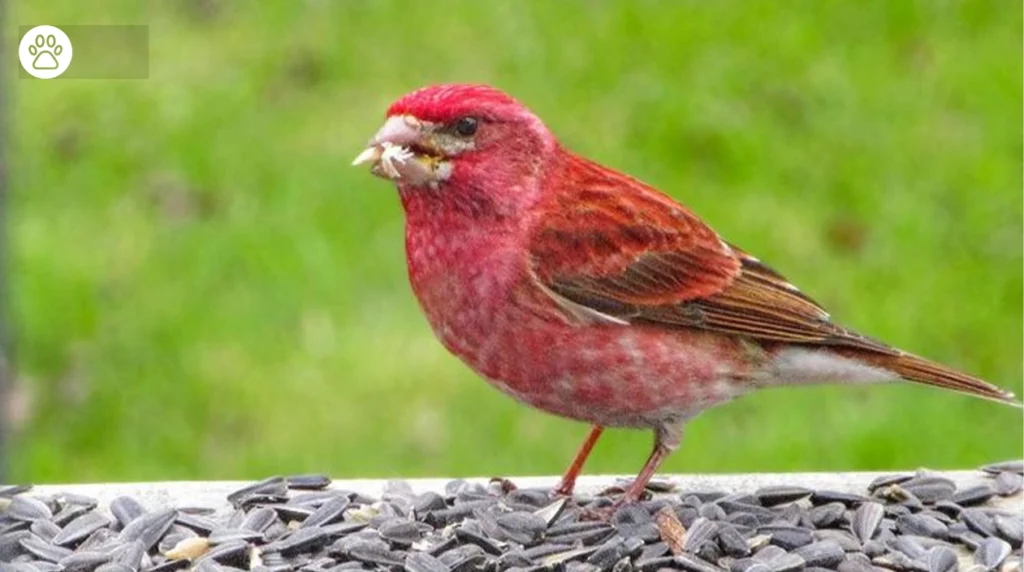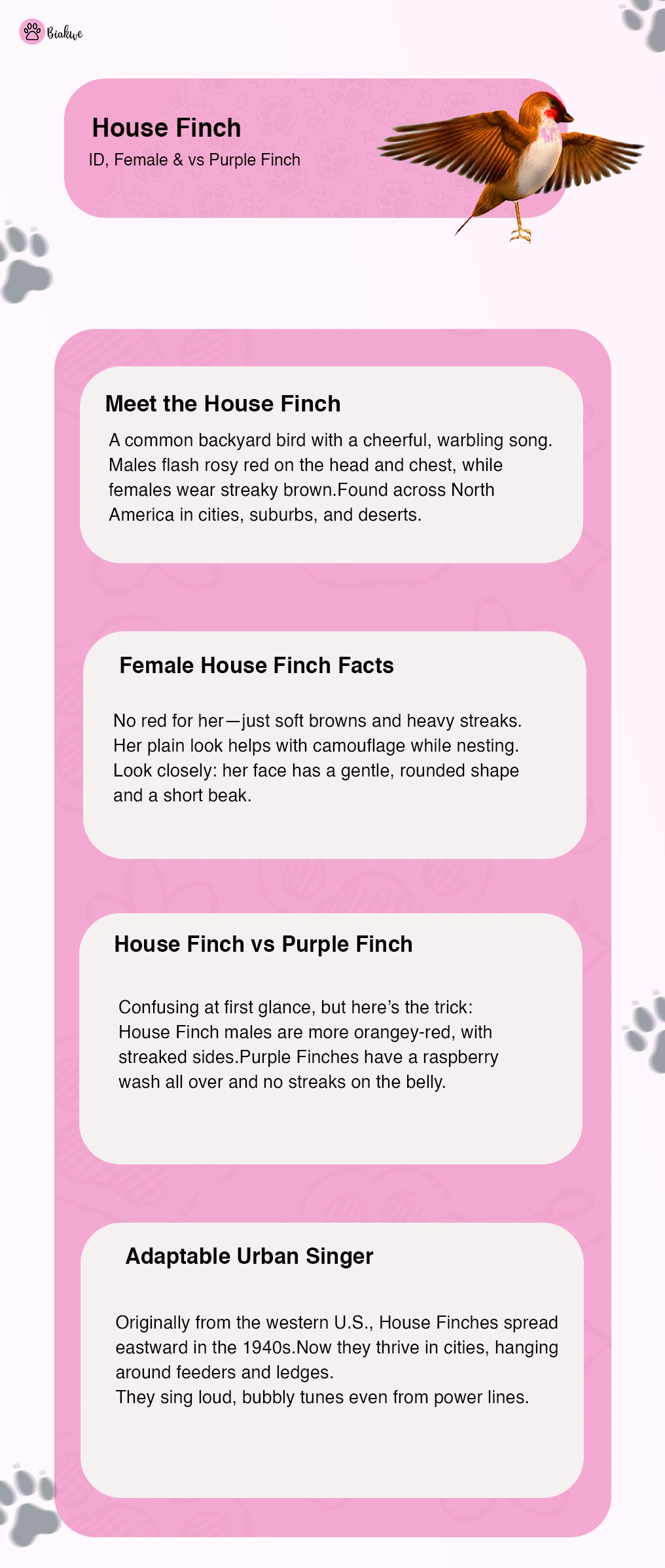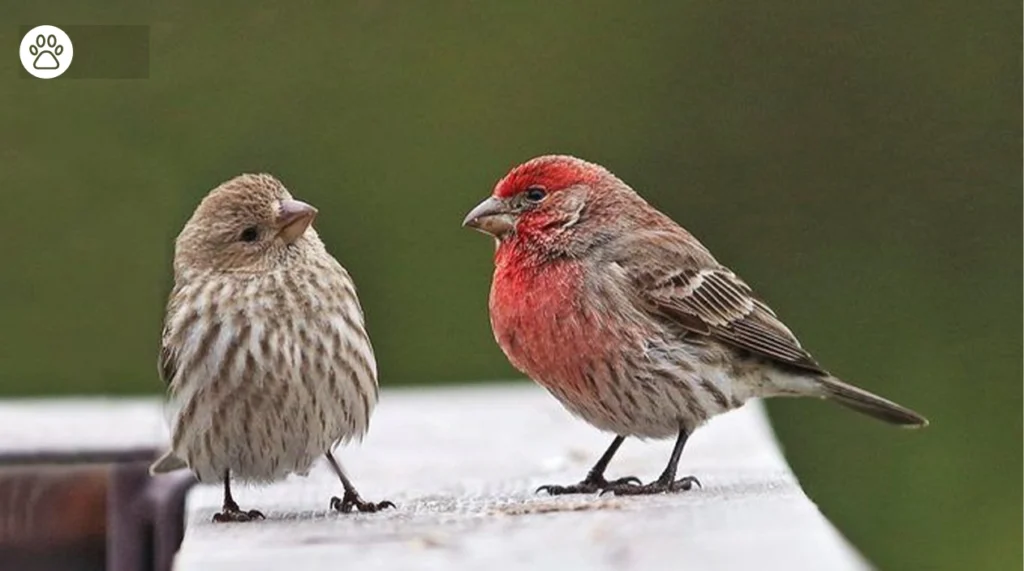In the blur of branches and rustle of leaves,
a flash of red flickers, then quickly deceives.
Is it the house finch, bold and bright?
Or the purple finch stealing light?
They chirp, they flit, they vanish fast
but which small songbird just flew past?
The house finch is everywhere, chirping from a wire, flitting past your porch light, perching confidently on a feeder like it owns the place. You’ve seen one, no doubt. But here’s the thing: it might not be what you think. Could it have been a purple finch instead? Or maybe a female house finch that fooled your eyes completely?
The difference between them is not always obvious at a glance. Blink and you’ll miss it.
Let’s break it down, piece by streaked piece.
What Is a House Finch?
The house finch bird (Haemorhous mexicanus) is a small, seed-loving songbird, native to the southwestern U.S. and Mexico, but now practically a staple across much of North America. It didn’t start this way. The species was originally a western bird. But thanks to an accidental introduction in New York during the 1940s (escaped cage birds sold as “Hollywood Finches”), house finches began a slow eastward march; and today, they’re everywhere.
They’ve adapted like pros. Strip malls, city trees, front yard feeders. No problem. You’ll see these finch birds bobbing on branches or sipping water from puddles without a care in the world. The house finch male wears a splash of red around the head and chest, though the exact shade changes depending on diet (more on that soon). The females? They wear brown, with streaks that confuse and challenge even experienced birders.

Visit: Dog Barking in Sleep? Causes, Meaning & What You Should Do
Meet the Purple Finch: House Finch’s Distant Cousin
The purple finch (Haemorhous purpureus) is slightly bulkier. Think of it as the stockier cousin with richer tones. And, ironically, it’s not even purple. Raspberry. Cranberry juice. Rose red. But not purple. Still, the name stuck. The male purple finch is flushed with this reddish-pink wash that covers the entire head, breast, and back. Unlike the house finch male, the red doesn’t look like it was dabbed on with a brush; it saturates the bird.
Purple finches aren’t quite as social around people. You’re more likely to find them in woodlands, especially up north. They show up at feeders, sure, but not with the same in-your-face confidence that house finches do. They migrate. They disappear. And they reappear; suddenly, usually in winter.
Female House Finch: The Master of Disguise
Now let’s talk about the female house finch, arguably one of the most frequently misidentified finches birds out there. She’s streaked all over with brown, has no bold facial markings, and looks like a bird that would rather not be noticed. Her head is plain, her underside is streaky, and her beak is slightly curved.
Compare that to the female purple finch, who shows off a cleaner look, with a strong white eyebrow line (a supercilium, if we’re getting fancy), and bolder contrast across her face. She looks sharp. Almost like someone outlined her features with a pencil.
Spotting a female house finch next to a purple finch female is like comparing pencil sketch to ink drawing. The difference is subtle, but it’s there, especially if you squint a little.
House Finch vs Purple Finch: Color, Shape, and Sound
There are three main ways to separate these finch birds: color, shape, and sound. And if you’re in doubt, pull out your binoculars and focus on these key differences:
- Color: The house finch male is tomato red, mostly on the front (face, throat, upper chest). The purple finch male is raspberry all over.
- Shape: House finches are longer, with a slimmer, more streamlined body. Purple finches look chunkier.
- Tail: House finches have a longer, notched tail. Purple finches? Shorter and more rounded.
- Bill: The house finch bird has a curved upper beak, while the purple finch’s beak is straighter and stouter.
- Song: The house finch sings a bubbly, chaotic song; loud, full of quick notes, often ending in a harsh “cheep.” The purple finch sings a richer, smoother tune, almost flute-like (according to Cornell’s Lab of Ornithology).

Discover: 2025 Dog Grooming Cost Guide: What to Expect for Pet Grooming Prices
House Finches: What the Red Really Means
Here’s something fascinating: the color of a house finch male’s red plumage is influenced by what he eats. Carotenoids from food, berries, fruits, and plants determine how red he becomes. A richer diet makes for a brighter bird. A duller red? It could be poor nutrition. Or molting. Or maybe he’s just not trying that hard.
This red also plays into mating. Studies show that females prefer redder males (Hill, 1991). The more vivid the red, the more likely he is to win a mate. Color here isn’t just decoration, it’s strategy.
A Visual Snapshot: House Finch vs Purple Finch
Here’s a quick glance table that breaks it all down. Save it. Screenshot it. Print and stick it on your fridge if you have to.
| Feature | House Finch | Purple Finch |
| Scientific Name | Haemorhous mexicanus | Haemorhous purpureus |
| Color (Male) | Tomato red on front areas | Raspberry red all over |
| Color (Female) | Brown, streaked, plain face | Bold face with white eyebrow |
| Body Shape | Long and narrow | Stocky and compact |
| Tail Shape | Long and slightly notched | Shorter, more rounded |
| Beak Shape | Curved upper ridge | Straighter and thick |
| Habitat | Suburbs, cities, open feeders | Forests, woodland edges |
| Range | Most of U.S. and Mexico | Northern U.S., Canada |
| Song | Fast and jumbled, ends sharply | Smooth, melodious |
| Feeder Frequency | Daily visitor, in groups | Occasional, mostly winter |
Why the Confusion Happens So Often
Birding isn’t always easy. The house finch and purple finch overlap in range, especially in parts of the East and Midwest. Toss in the female house finch, and now we’ve got a whole mess of brown birds with streaks.
Lighting plays tricks. So does distance. One minute you’re confident, the next you’re second-guessing every feather. Even experts can get it wrong.
One trick? Watch their behavior. House finches are bold. They’ll nest in wreaths, under eaves, or in potted plants. Purple finches? They’re forest birds. They don’t hang around people as much. So location matters.
Explore: Pet Boarding Review 2025: Is Petshotel the Right Choice for Your Pet?
Therefore: Finches Birds are worth Watching
Bird feeders tell stories, next time one of those small brown birds lands near yours, take a pause, and look closer, is it streaky or bold; is that red a true raspberry or more tomato sauce; these questions lead to better IDs and, maybe, a deeper appreciation for just how much is happening right outside your window.
Both house finches and purple finches are common, but they’re not interchangeable i.e, each has its flair, its song, its little corner of the birdwatching universe. It could be the flashy red male or the thoroughly understood brown female house finch, they’re all worth a second look.
You may grab your binoculars, cue up a birdsong app, and next time whenever you spot a finch bird, ask yourself: which finch just flew by and analyze the effect of our guide’s helpfulness.

Learn More: Dog Ear Infection Treatment – Safe Home Remedies That Work
